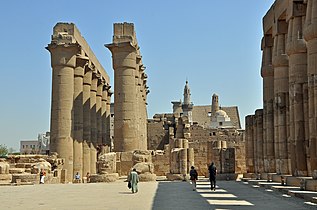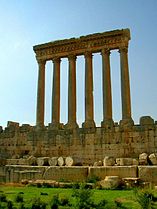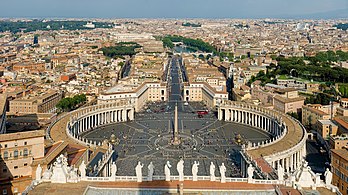Colonnade

In classical architecture, a colonnade is a long sequence of columns joined by their entablature, often free-standing, or part of a building.[1] Paired or multiple pairs of columns are normally employed in a colonnade which can be straight or curved. The space enclosed may be covered or open. In St. Peter's Square in Rome, Bernini's great colonnade encloses a vast open elliptical space.
When in front of a building, screening the door (Latin porta), it is called a portico. When enclosing an open court, a peristyle. A portico may be more than one rank of columns deep, as at the Pantheon in Rome or the stoae of Ancient Greece.
When the
History
Colonnades (formerly as colonade) have been built since ancient times and interpretations of the classical model have continued through to modern times, and Neoclassical styles remained popular for centuries.
Notable colonnades
Ancient world
-
The colonnade of Amenhotep III at theLuxor temple
-
The Stoa of Attalos in the reconstructed Ancient Agora of Athens
-
Baalbeck, Lebanon
-
Las Incantadas colonnade, demolished in 1864 by Emmanuel Miller
-
Modern colonnade at the Santa Lucia rail station, Venice
-
Piliers de Tutelle, Gallo-Roman portico demolished in 1677, France
Renaissance and Baroque periods
-
Palace of Charles V, Granada (1527)
-
Detail of St. Peter's Square colonnade
-
Colonnade of the Louvre, Paris (1670)
Neoclassical
-
The church of La Madeleine, Paris (consecrated 1842)
-
Vaulted colonnade in the General Post Office, Sydney (1890s)
-
Main entrance to the Fitzwilliam Museum, University of Cambridge (19th century)
-
Colonnade of theArcade du Cinquantenaire, Brussels(1905)
-
New York State Education Building, Albany, New York (1912)
Modern interpretations
-
Lebus Court, Bridges Hall of Music, Pomona College, by Myron Hunt in Claremont, California, United States (1915)
-
Balch Hall, Scripps College by Sumner Hunt and Gordon Kaufmann in Claremont, California, United States (1929)
See also
References
- ^ Colonnade from Encyclopædia Britannica
- ^ This article incorporates text from a publication now in the public domain: Chisholm, Hugh, ed. (1911). "Araeosystyle". Encyclopædia Britannica. Vol. 2 (11th ed.). Cambridge University Press. p. 312.
- ISBN 0442016662.
- ^ Student Resource Glossary
- ^ New York State Department of Education Building[dead link]. Emporis. Retrieved on 2009-5-23.




















